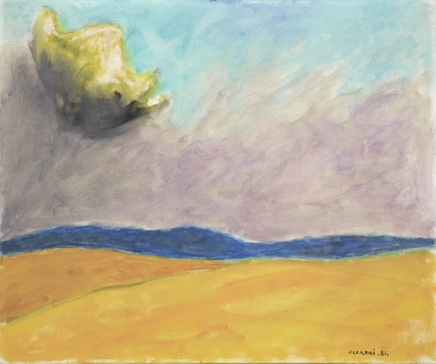Memento vitae. Paintings by Józef Czapski in the collections of the National Museum in Krakow
16.02-04.08.2024
“Friday. I only wrote on the cover of this new notebook: memento! Because here I wasn’t talking only about memento Mori, but about memento Vitae, which still awaits me, whether this life will last a day or a few years!” – wrote 91-year-old Józef Czapski in one of his last diaries.
The exhibition Memento vitae is the first presentation of the entire collection of Czapski’s paintings in the collections of the National Museum in Krakow.
This collection currently includes (as at the end of December 2023) 27 oil paintings and 2 oil sketches for paintings. It was created mainly thanks to gifts and individual purchases. Already in 1958, thanks to the efforts of the legendary curator of the Museum, Helena Blum, was purchased directly from the author Red Café (1956), in 1960 Altar Boys (1955), and in 1967 Old Woman – Femme Forte (1965). In 1991, thanks to Tadeusz Nyczek, the National Museum in Krakow purchased Woman in the Window (1977) from the collection of Katarzyna and Zbigniew Herbert, and in 2021–2022 Couple (undated) and Young Men on the Beach in Dinard (1970) from Renata and Marek Szypulski.
Czapski’s paintings from their collections were donated to the NMK by Elżbieta Colin-Łubieńska, Barbara and Richard Aeschlimann, Adela Maria Żeleńska née Bohomolec and Władysław Żeleński, the Łubieńska sisters – Róża (artistic pseudonym Rula Lenska), Gabriela Łubieńska-Steele and Anna, Lady Frances Phipps, Krystyna Zachwatowicz-Wajda and Andrzej Wajda, Renata and Marek Szypulski and the Polish Humanitarian Fund (Fonds Humanitaire Polonais) in Lailly-en-Val in France.
The earliest painting in our collection is Patrycja Newey in “Tosca” (1953); the latest ones come from the late 1980s and early 1990s, when the artist was already – as he wrote in his diaries – “almost completely blind”.
Józef Czapski, although he drew from French painting and was forced to live and create in exile, saw his painting primarily in Poland, against the background of Polish painting. Towards the end of his life, he thought about the meaning of his work and what would remain.
“So what did our Kapist wave and me in particular bring? Torment by pure painting. What does it mean? […]
Maybe my testament is just a painting will to raise the level of PAINTING QUALITÉ at least by a small level in Poland, where my painting is only known. […] Whether any of this will come into being or whether it will be swallowed up by the new end of the world is none of my business!”
curator: Agnieszka Kosińska
Fragments from Józef Czapski’s diary no. 240, dated November–December 1987, titled Memento, and from diary no. 255, dated 27 November–20 December, 1988 (Archive of Józef and Maria Czapski in the National Museum in Krakow). Reading and transcription: Maria and Janusz S. Nowak. Underscoring and distinctions: Józef Czapski. Quotes from Józef Czapski’s diary. Copyright © by Weronika Orkisz
MNK The Czapski
ul. Piłsudskiego 12, 31-109 Kraków- Monday: closed
- tue: 10.00-18.00
- wednesday-sunday: 10.00-16.00